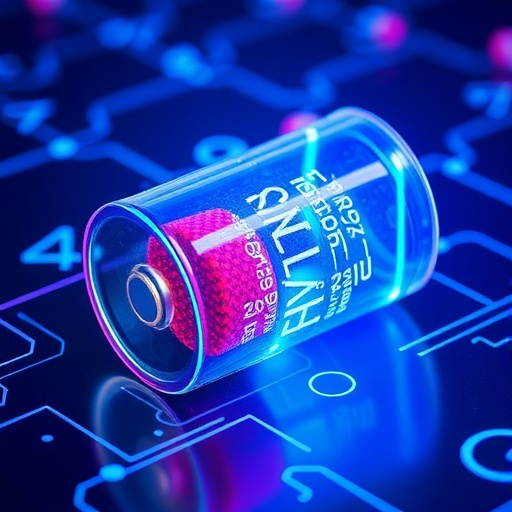The necessity for accurate prediction models in the realm of lithium-ion batteries has never been more pressing as the demand for electric vehicles and renewable energy storage systems surges. These systems are pivotal to modern technological ecosystems, and accurately estimating their remaining useful life (RUL) is crucial for optimizing performance and ensuring safety. A breakthrough has emerged from a recent study, revealing a sophisticated multi-stage capacity trajectory prediction model designed specifically to revolutionize RUL estimation for lithium-ion batteries.
Researchers Gao, Lin, Liu, and their team developed an innovative fusion model that combines several advanced methodologies, including Complete Ensemble Empirical Mode Decomposition with Adaptive Noise (CEEMDAN), Augmented Unscented Kalman Filter (AUKF), Singular Spectrum Analysis (SSA), and Gated Recurrent Units (GRU). This amalgamation of techniques represents a significant leap forward in the accuracy and reliability of lithium-ion battery assessments, which could have profound implications for various applications ranging from consumer electronics to electric grid management.
At the core of the study lies the CEEMDAN, which serves as a powerful signal processing method. This technique breaks down complex battery performance data into simpler, interpretable components, thereby enhancing the subsequent analysis phases. By isolating the inherent patterns in voltage and current data, CEEMDAN enables researchers to observe fluctuations and trends that were previously obscured. This is a crucial step for understanding how battery capacity evolves over time, particularly as batteries undergo cyclical usage and stress.
The next significant component of the fusion model is the AUKF, which is essential for efficient state estimation. This recursive filtering approach allows for the incorporation of both current measurements and past data, effectively refining predictions of battery performance. By utilizing the AUKF alongside the insights gleaned from CEEMDAN, the researchers create a robust framework that adapts as conditions change. This adaptability is key to addressing the variability that often plagues lithium-ion battery performance, stemming from factors such as temperature fluctuations and different charging habits.
Moving further into the model, the SSA technique is integrated to analyze data trends over time. By extracting significant patterns from the battery’s historical data, SSA enables better predictions by holding onto the most relevant information while filtering out noise. This focused approach ensures that the analysis remains as precise as possible, which is particularly beneficial in real-world applications where accuracy can dictate the lifespan and reliability of batteries.
The final piece of this sophisticated puzzle is the GRU, a machine learning architecture that has gained popularity due to its efficiency in processing sequences. GRUs are especially adept at retaining long-term dependencies in time series data, making them highly effective for predicting future capacity trajectories based on historical performance. By feeding the predictions from the previous stages into the GRU, the researchers can formulate highly accurate forecasts concerning a battery’s future capacity, which is instrumental for RUL calculations.
Critical validation tests were a significant aspect of the research, allowing the team to demonstrate the effectiveness of their fusion model against existing standards. The validation process tested the model under various conditions that closely mimic real-world scenarios, cementing the practicality of their approach. By achieving impressive accuracy metrics during validation, the model not only proves to be a theoretical advancement but shown its potential for practical applications across industries.
Industry experts have responded positively, noting that this research could lead to profound changes in battery management systems. Improved RUL predictions can facilitate more informed decisions regarding battery usage and maintenance strategies, extending the life cycles of batteries significantly. This can contribute to reduced waste and improved sustainability practices, aligning with global efforts towards environmental conservation.
In addition to electric vehicles, the implications of enhanced lithium-ion battery RUL estimation extend to renewable energy systems, such as solar and wind energy storage setups. These systems rely heavily on battery performance for stability and efficiency, and precise RUL predictions can ensure that energy storage remains reliable, thus broadening the appeal of renewable energy sources in mainstream applications.
The technology also offers promising avenues for markets that require robust electric power sources, including consumer electronics. As devices become more integrated with battery technology, ensuring their longevity through accurate capacity predictions can enhance user experiences while minimizing cost impact over time. With the model developed by Gao et al., it may soon be commonplace to see enhanced battery management systems in future electronic devices, drastically shifting how we interact with technology daily.
This innovative fusion model exemplifies the synergy of traditional methodologies and cutting-edge machine learning techniques. By adopting such a comprehensive approach, the study paves the way for future research endeavors that may build upon these foundations. Ongoing work in this area could lead to further refinements in battery technology or related predictive models that could be adapted to other domains beyond lithium-ion batteries.
In conclusion, the journey toward more efficient and sustainable battery technology is undeniably aided by the research efforts of Gao, Lin, Liu, and their team. Their fusion model for multi-stage capacity trajectory predictions harnesses several advanced techniques to outperform traditional models, promising a new era of reliability and efficiency in lithium-ion battery operations. As research continues to evolve, the integration of such innovative methods may ultimately reshape the landscape of energy storage, powering a more sustainable future.
Subject of Research: Multi-stage capacity trajectory prediction for lithium-ion battery RUL estimation.
Article Title: Multi-stage capacity trajectory prediction for lithium-ion battery RUL estimation: CEEMD-AUKF-SSA-GRU fusion model and validation.
Article References:
Gao, K., Lin, J., Liu, . et al. Multi-stage capacity trajectory prediction for lithium-ion battery RUL estimation: CEEMD-AUKF-SSA-GRU fusion model and validation.
Ionics (2025). https://doi.org/10.1007/s11581-025-06669-4
Image Credits: AI Generated
DOI: https://doi.org/10.1007/s11581-025-06669-4
Keywords: Lithium-ion battery, RUL estimation, capacity prediction, CEEMD, AUKF, SSA, GRU, machine learning, energy storage, sustainability, electric vehicles, renewable energy.
Tags: advanced methodologies in battery assessmentAugmented Unscented Kalman FilterComplete Ensemble Empirical Mode Decompositionelectric vehicle battery managementfusion approach in energy technologyGated Recurrent Units for battery analysislithium-ion battery lifespan predictionmulti-stage capacity trajectory modeloptimizing battery performance and safetyremaining useful life estimationrenewable energy storage systemssingular spectrum analysis in battery research





